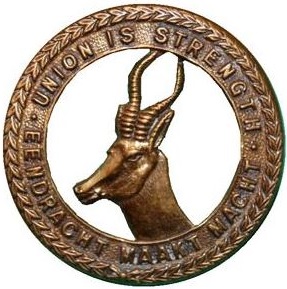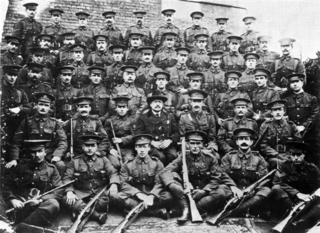
The Chambeshi Monument, in the Northern Province of Zambia, also called the Chambeshi Memorial and the Lettow-Vorbeck Memorial, commemorates the final cessation of hostilities of the First World War, three days after the Armistice in Europe.

The Chambeshi Monument, in the Northern Province of Zambia, also called the Chambeshi Memorial and the Lettow-Vorbeck Memorial, commemorates the final cessation of hostilities of the First World War, three days after the Armistice in Europe.
The monument bears a plaque which reads:
On this spot at 7.30 am on Thursday 14th November 1918, General von Lettow-Vorbeck, commanding the German forces in East Africa, heard from Mr Hector Croad, then District Commissioner Kasama, of the signing of the Armistice by the German government, which provided for the unconditional evacuation of all German forces from East Africa.
A second plaque in the Bemba language ends with the words
Twapela umuchinshi kuli bonse abashipa abalwile mu nkondo iyi ("We honour all brave soldiers who fought in this war.) [1]
The message given to General von Lettow-Vorbeck was a telegram sent to Croad which read
Please send the following to General von Lettow-Vorbeck under a white flag - The English Prime Minister [ sic ] sent notice that on 11th November an Armistice was signed and that the fighting on all fronts should cease on 11th November at 11 o'clock. I order my troops to end hostilities as from now and I expect you to do the same. General van Deventer.
Hence the Memorial marks the cessation of hostilities, not the surrender. [2]
The location of the Monument is on the north bank of the Chambeshi River, near the northern end of the old Chambeshi Bridge (which was built later, this bridge was destroyed by Rhodesian troops during the Rhodesian Bush War, a new bridge was built further upstream) on the Mpika-Kasama road. Most accounts of the war say that Lettow-Vorbeck surrendered at Abercorn, 250 km to the north, giving the impression that he penetrated just the few kilometres to Abercorn from German East Africa but that is only because he was instructed by Allied commanders in Northern Rhodesia to march his troops there for the official surrender on 23 November 1918. [3]
The British force had been waiting in the Abercorn area to attack the German forces coming from northern Mozambique, thinking they would make for Lake Tanganyika, but General von Lettow-Vorbeck had evaded them by turning south-west towards Kasama. Its tiny British population evacuated to Mpika, [4] except for nine who set up two Maxim guns at the Chambeshi, but they did not know how to work them. One, Charlie Simpson, had with him about £10,000 which was all the cash from the government offices and businesses in Kasama, which he buried in a goat pen near the rubber factory he ran, thinking that the goats' hoofprints would hide evidence of digging, and that the Germans would probably be more interested in the goats than looking for the money. On arrival at the Chambeshi the Germans machine-gunned the rubber factory before Croad arrived with the telegram. [5]
The Monument was unveiled on 14 November 1953 as a National Monument of Northern Rhodesia (now Zambia) and consists of a large stone platform with the plaques set into a stone pillar, next to a cannon of the era (but not one used by the Germans). [2]

Paul Emil von Lettow-Vorbeck, popularly known as the Lion of Africa, was a general in the Imperial German Army and the commander of its forces in the German East Africa campaign. For four years, with a force of about 14,000, he held in check a much larger force of 300,000 British, Indian, Belgian, and Portuguese troops. He is known for never being defeated or captured in battle.

The Armistice of 11 November 1918 was the armistice signed at Le Francport near Compiègne that ended fighting on land, at sea, and in the air in World War I between the Entente and their last remaining opponent, Germany. Previous armistices had been agreed with Bulgaria, the Ottoman Empire and Austria-Hungary. It was concluded after the German government sent a message to American president Woodrow Wilson to negotiate terms on the basis of a recent speech of his and the earlier declared "Fourteen Points", which later became the basis of the German surrender at the Paris Peace Conference, which took place the following year.

The Battle of Tanga, also known as the Battle of the Bees, was an unsuccessful invasion of the Port of Tanga in German East Africa by the British Indian Expeditionary Force "B" on 3–5 November 1914 during World War I. Under the command of the Major-General Arthur Aitken, British forces attacked Tanga in concert with Indian Expeditionary Force "C", which concomitantly attempted to capture Longido. The battle was the first major engagement of the East African campaign and saw Aitken's troops defeated by a smaller force of German Schutztruppe under Paul von Lettow-Vorbeck and forced to retreat. Lettow-Vorbeck's men captured weapons, medical supplies, tents, blankets, rations and several Maxim guns after the battle, which played a major role in allowing his troops to resist the Allies for the rest of the world conflict.
Mbala is Zambia's most northerly large town and seat of Mbala District in Northern Province, occupying a strategic location close to the border with Tanzania and controlling the southern approaches to Lake Tanganyika, 40 km by road to the north-west, where the port of Mpulungu is located. It had a population of about 20,000 in 2006. Under the name Abercorn, Mbala was a key outpost in British colonial control of this part of south-central Africa.

The Battle of Jassin was a World War I battle that took place on 18– 19 January 1915 at Jassin on the German East African side of the border with British East Africa between a German Schutztruppe force and British and Indian troops. Jassin had been occupied by the British in order to secure the border between British East Africa and German territory, but was weakly defended by a garrison of four companies of Indian troops, commanded by Colonel Raghbir Singh and numbering a little over 300 men. Colonel Singh was killed during the battle.
The following lists events that happened during 1918 in South Africa.
Kasama is a town in the Northern Province of Zambia. It serves as the provincial capital and the headquarters of Kasama District.
Kasanga, known as Bismarckburg during the German colonial rule, is a town in Rukwa Region, Tanzania. It is located at around 8°27′30″S31°8′10″E, on the shore of Lake Tanganyika, 810 m above sea level.

The African theatre of the First World War comprises campaigns in North Africa instigated by the German and Ottoman empires, local rebellions against European colonial rule and Allied campaigns against the German colonies of Kamerun, Togoland, German South West Africa, and German East Africa. The campaigns were fought by German Schutztruppe, local resistance movements and forces of the British Empire, France, Italy, Belgium, and Portugal.

The East African campaign in World War I was a series of battles and guerrilla actions, which started in German East Africa (GEA) and spread to portions of Mozambique, Rhodesia, British East Africa, the Uganda, and the Belgian Congo. The campaign all but ended in German East Africa in November 1917 when the Germans entered Mozambique and continued the campaign living off Portuguese supplies.

The South African Overseas Expeditionary Force (SAOEF) was a volunteer military organisation in World War I.

The Carrier Corps was a labour corps created in Kenya during the First World War to provide military labour to support the British campaign against the German Army in East Africa.

The following outline is provided as an overview of and topical guide to Zambia:
Zambia, officially known as the Republic of Zambia, is a landlocked country in Southern Africa. The neighbouring countries are the Democratic Republic of the Congo to the north, Tanzania to the north-east, Malawi to the east, Mozambique, Zimbabwe, Botswana, and Namibia to the south, and Angola to the west. The capital city is Lusaka, located in the southeast of the country. The population is concentrated mainly around the capital and the Copperbelt to the northwest.

The Battle of Ngomano or Negomano was fought between Germany and Portugal during the East African Campaign of World War I. A force of Germans and Askaris under Paul Emil von Lettow-Vorbeck had recently won a costly victory against the British at the Battle of Mahiwa, in present-day Tanzania and ran very short of food and other supplies. As a consequence, the Germans invaded Portuguese East Africa to the south, both to supply themselves with captured Portuguese materiel and escape superior British forces to the north.

In August 1914, the United Kingdom declared war on the German Empire at the start of World War I. The settler society in Southern Rhodesia, which were administered by the British South Africa Company, received the news with great patriotic enthusiasm. The Company administrator, Sir William Milton, wired the British government, saying, "All Rhodesia... ready to do its duty". Although it supported the British Empire, the company was concerned about the possible financial implications for its chartered territory to make direct commitments to the war effort, particularly at first. As a result, most of the colony's contribution to the war was made by Southern Rhodesians individually—not only those who volunteered to fight abroad, but also those who remained at home and raised funds to donate food, equipment and other supplies.

Southern Rhodesia, then a self-governing colony of the United Kingdom that was located in the now-independent Zimbabwe, entered World War II along with Britain shortly after the invasion of Poland in 1939. By the war's end, 26,121 Southern Rhodesians of all races had served in the armed forces, 8,390 of them overseas, operating in the European theatre, the Mediterranean and Middle East theatre, East Africa, Burma and elsewhere. The territory's most important contribution to the war is commonly held to be its contribution to the Empire Air Training Scheme (EATS), under which 8,235 British, Commonwealth and Allied airmen were trained in Southern Rhodesian flying schools. The colony's operational casualties numbered 916 killed and 483 wounded of all races.

Ruga-Ruga were irregular troops in Eastern Africa, often deployed by western colonial forces. They often served as mercenaries or local auxiliaries alongside the regular Askari, professional soldiers who were often hired in other regions of Africa. While the latter were trained by officers of the European colonial powers in Africa, the Ruga-Ruga were mostly hired from tribal warriors during times of conflict.

Brigadier general William Frederick Savery Edwards (1872–1941), commonly referred to as Brigadier-General W. F. S. Edwards, was a decorated British military officer who was appointed by the British Colonial Administration as the first Inspector General of the Uganda Protectorate Police, which later became the Uganda Police, and the simultaneous overall commander of the then British East Africa Police.

The Mbala War Memorial is a First World War memorial which stands on a roundabout on the M1 road heading south from the centre of Mbala, Zambia. The truncated red stone column was one of the last war memorials designed by Edwin Lutyens. It commemorates almost 1,500 native carriers from North Rhodesia who died in action, or from wounds or sickness, during the East African campaign. Their names are not recorded.